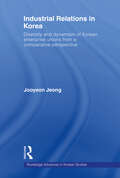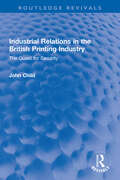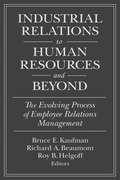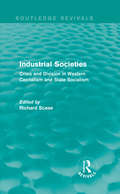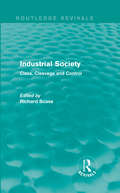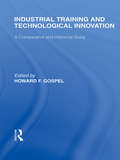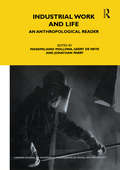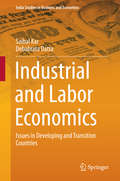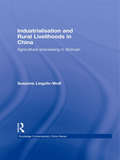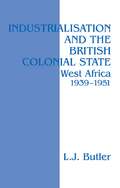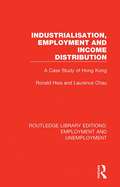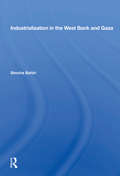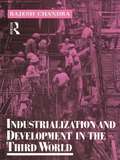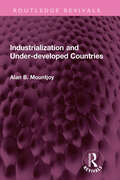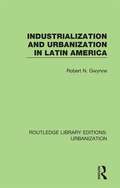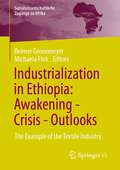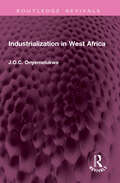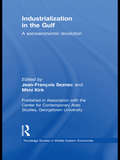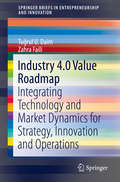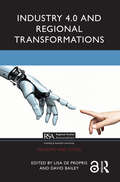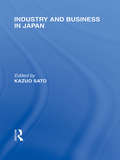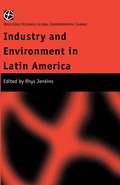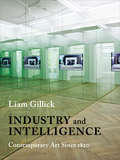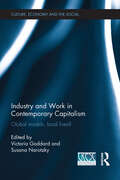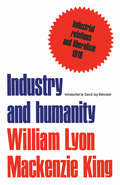- Table View
- List View
Industrial Relations in Korea: Diversity and Dynamism of Korean Enterprise Unions from a Comparative Perspective (Routledge Advances in Korean Studies)
by Jooyeon JeongA key factor in Korea's economic success is the nature of industrial relations in Korean business and industry. Joo-Yeon Jeong presents a comprehensive survey of the current state of industrial relations in Korea. He shows how union membership has changed over recent decades, and how the focus of bargaining has widened from purely financial considerations to include a much wider range of issues including, principally, issues related to job security. In addition, the book considers the role of government in shaping the legal and institutional environment, and of employers, who have taken a more aggressive role towards unions since the mid-1990s.
Industrial Relations in the British Printing Industry: The Quest for Security (Routledge Revivals)
by John ChildFirst published in 1967, Industrial Relations in the British Printing Industry was written to provide a comprehensive picture of the development of organisations of both employers and those employed in the British printing industry. The book traces the story from the seventeenth century Craft Guilds and the Stationers Company, through the development of trade unions and union rule in the nineteenth century and up to the technical revolution of the early 1900s. Later chapters cover in detail problems such as restrictive practices and productivity bargaining in the thirty years prior to the original publication of the book. It also explores how their aims and strategies are related to changing technological and economic conditions. Industrial Relations in the British Printing Industry will appeal to those with an interest in social history and the history of industrial relations, particularly with regards to the printing industry.
Industrial Relations to Human Resources and Beyond: The Evolving Process of Employee Relations Management (Issues In Work And Human Resources Ser.)
by Bruce E. Kaufman Richard A. Beaumont Roy B. HelfgottThis collection examines the evolution of the philosophy and practice of human resource management (HRM) and industrial relations (IR) over the twentieth century. By combining history, contemporary practice, and future trends, these well-known experts present both scholarly and practitioner perspectives. Drawing on in-depth interviews and surveys with HRM executives at leading corporations, the contributors explore key trends and issues facing global companies in such areas as equal opportunity, compensation practices, and expatriation programs. The book also takes an in-depth look at one particular player in the story - Industrial Relations Counselors, Inc., the first non-profit research and consulting organization dedicated to improved HRM/IR practices - which was founded by John D. Rockefeller in 1926, and has played a central role in the development of key labor legislation including the Social Security Act.
Industrial Societies: Crisis and Division in Western Capatalism (Routledge Revivals)
by Richard ScaseThis book, first published in 1989, addresses an issue that stood at the centre of sociological concern – the changing character of industrial societies. The authors examine the nature of the industrialization process, in terms of its impact upon and development within both state socialist and capitalist societies. Is ‘industrialism’ a constant phenomenon within both kinds of society, or are distinctive differences apparent? In the 1960s, it did seem that economic growth and technological change were producing similarities in social structure between the different socio-political systems; it now appears however that the crisis that have developed during the 1980s how illustrated their contrasts. Through the analysis of this trend in the West, in Eastern Europe and in China the authors clarify central issues for the student of sociology: The changing character of national states, organized labour, stratification systems and class relationships Processes of social integration, cohesion and control The extent to which dominant groups are able to sustain social and economic privileges in different socio-economic systems The changing pattern of work and employment relationships The nature of class, gender and ethnicity as sources of socio-economic division
Industrial Society: Class, Cleavage and Control (Routledge Revivals)
by Richard ScaseAny study of contemporary industrial societies must take into account the role of power, ideology and class, and the degree to which these determine the development of social structures. This book, first published in 1977 and based on a selection of eleven papers given at a conference of the British Sociological Association, focuses upon aspects of continuity and change in modern society, comparing and contrasting dimensions of class, cleavage and control in capitalist and socialist societies. This book is key reading for students of both sociology and business studies.
Industrial Training and Technological Innovation: A Comparative and Historical Study (Routledge Library Editions: Japan)
by Howard F. GospelTaking an international and comparative perspective, this book focuses on the relationship between industrial training and technological change in three major global economies – the UK, USA and Japan. The contributors, an international group of leading researchers, look at the origins and development of training in these countries, and analyse the benefits resulting from the interaction of a skilled workforce and technological change. This analysis of training in major industrial nations reveals the full complexity of the relationship between labour and technological change. It shows the value of an approach which is both historical and comparative, and highlights the importance of education and training as a necessary basis for successful innovation.
Industrial Work and Life: An Anthropological Reader (LSE Monographs on Social Anthropology #92)
by Massimiliano Mollona; Geert De Neve; Jonathan ParryIndustrial Work and Life: An Anthropological Reader is a comprehensive anthropological overview of industrialisation in both Western and non-Western societies. Based on contemporary and historical ethnographic material, the book unpacks the 'world of industry' in the context of the shop floor, the family, and the city, revealing the rich social and political texture underpinning economic development. It also provides a critical discussion of the assumptions that inform much of the social science literature on industrialisation and industrial 'modernity'. The reader is divided into four thematic sections, each with a clear and informative introduction: historical development of industrial capitalism; shopfloor organisation; the relationships between the workplace and the home; the teleology of industrial 'modernity' and working-class consciousness. With readings by key writers from a range of backgrounds and disciplines, Industrial Work and Life is the essential introduction to the study of industrialisation in different societies. It will appeal to students across a wide range of subjects including: anthropology, comparative sociology, social history, development studies, industrial relations and management studies. Includes essays by: E.P. Thompson, Aihwa Ong, Jonathan Parry, Thomas C. Smith, Harry Braverman, Michael Burawoy, Huw Beynon, Françoise Zonabend, James Carrier, Leslie Salzinger, Ching Kwan Lee, Ronald Dore, Tom Gill, Carla Freeman, Max Gluckman, James Ferguson, Chitra Joshi, Lisa Rofel, Geert De Neve, Karl Marx, Rajnarayan Chandavarkar, Robert Roberts, June Nash, Christena Turner.
Industrial and Labor Economics
by Saibal Kar Debabrata DattaThis book is an attempt to capture and analyze several idiosyncratic features of industry and labor in the developing world. Available books and graduate-level texts in labor economics largely discuss industrial and labor market situations prevalent in developed countries, where well-defined institutional arrangements and regulations create a very different scope of analysis. The patterns of choice in training and contracts in the labor market more apparent in developing and transition countries are discussed, as are the information-theoretic results. The book also critically examines labor migration, a context in which the developing and transition countries represent large sources in the present global order. A broad base of empirical observations from industries is used to develop analytical conjectures on risk-sharing arrangements between workers and employers, while strong intuitive explanations are combined with relevant mathematical and graphical derivations, ensuring the book's readability among graduate students pursuing courses in labor economics and industrial economics for developing and transition countries. The book may also serve as a valuable reference guide for all students in advanced human resources courses at management schools. Presenting state-of-the art research findings in all of its chapters, the book discusses numerous institutional peculiarities of the developing world, making the results distinct in view of the general scope of labor economics.
Industrialisation and Rural Livelihoods in China: Agricultural Processing in Sichuan (Routledge Contemporary China Series)
by Susanne Lingohr-WolfSince the mid-1990s, "agricultural industrialisation" (AI) has been advocated in China to promote rural development by integrating agriculture with the post-harvest sectors such as agro-processing and marketing. Large-scale "Dragon head enterprises" (DHEs) and various forms of rural household associations (RAs) have been particularly promoted as AI organisational models. Drawing on the case study of the sweet potato sector in Sichuan Province, this book investigates their impact on rural livelihoods. Lingohr-Wolf analyses the forms of household linkages with AI organisations, the underlying household incentives to diversify both labour and agricultural production towards AI, and the developmental benefits and potential constraints that shape such rural involvement. By taking a rural household perspective on livelihood diversification, the analysis provides new insights into the links between rural household involvement in AI and the achievement of development objectives. It reveals that although there are significant beneficial effects, a number of challenges, such as entry barriers and imbalances in bargaining power, still need to be addressed to improve the positive impact of AI for rural development in China. As the first authoritative analysis of AI in China, this book is an essential read for scholars interested in economic development in China and rural development and agricultural economics more generally.
Industrialisation and the British Colonial State: West Africa 1939-1951
by Lawrence ButlerTaking colonial policy towards West Africa as a case study, Butler shows that, during the 1940s, the Colonial Office evolved a policy of encouraging colonial industry as part of a broad programme of development intended to prepare colonies for independence.
Industrialisation, Employment and Income Distribution: A Case Study of Hong Kong (Routledge Library Editions: Employment and Unemployment #3)
by Ronald Hsia Laurence ChauFirst published in 1978. In spite of the wide recognition of Hong Kong’s successful growth record, little is known about the impact that rapid industrialisation has had on income distribution. The transformation of an entrepôt economy into an industrial one has been accompanied by a transition from a labour surplus to a labour shortage economy, which has had a profound influence on the distribution of income by size. The effect has been channelled through a number of variables such as the composition of employment by industry, occupational structure, labour force participation rate and wage structure. All these changes have, moreover, owed much to the existence of a market mechanism which has been virtually free from government intervention. Beginning with a comprehensive evaluation of the effects of the various characteristics of employment and the labour force on household income distribution, this study assesses the impact of Hong Kong’s industrialisation and employment growth on its income distribution. Through an analysis of the changes in industrial and occupational structures, employment status, household size, labour participation rate, inflow of labour and wage and employment structures, it considers not only how income distribution alters with economic development, but also the mechanism that has brought about these changes. The redistribution effect of government activities is examined and the incidence of particular taxes to different income groups is apportioned to give a clear overall picture. Finally, the benefits obtained from government expenditures on housing, education and health are measured and are allocated to different income groups, illustrating how this has appreciably reduced income inequality in Hong Kong.
Industrialization In The West Bank And Gaza
by Simcha BahiriThe West Bank and Gaza Strip, occupied by Israel since 1967, have stagnated in the number employed (some 17,000) in domestic industry for 20 years and in the percentage contribution (8.5 per cent) to the gross domestic product. Their 4,000 establishments are mostly workshops employing on average just over four workers. Food and textiles are the dominant industries and there is much sub-contracting for Israeli firms. Some 90 per cent of industrial imports come from or through Israel and some 70 per cent of their industrial exports go to Israel, with the remainder going to or through Jordan. There are many barriers to the development of industry in the occupied territories but they overwhelmingly have their origin in the occupation itself and to a lesser degree result from difficulties made by Jordan. The Military Government runs the territories to ensure not only military security but also Israel's "economic security." Three alternative economic scenarios are projected to 1997 based on three possible futures facing the territories: (a) a conservative scenario based on continuing the occupation in its present form (status quo); (b) a reformist scenario in which both Israel and Jordan liberalize their policies within the framework of continued occupation; and (c) a radical scenario in which Israel leaves the territories in return for peace, and a separate Palestinian entity is established. In terms of industrial development the conservative scenario would yield minimal results, the reformist scenario some minor improvements in the "quality of life," and the radical scenario would result in rapid industrial development and settlement of returning refugees.
Industrialization and Development in the Third World (Routledge Introductions to Development)
by Rajesh ChandraDeveloping countries have undergone significant industrialization in the last three decades. Yet industrial growth reveals marked spatial inequalities in terms of both country and location. The Newly Industrialised Countries have achieved spectacular growth in sharp contrast to many other countries of the South. Industrial structure has changed, moving away from labour intensive industries to more technologically advanced manufacturing. Developing countries have had considerable success in penetrating developed country markets but they are now encountering more market restrictions. The role of the government in the development of the economy is also changing. Increasingly, countries are turning towards export-orientated industrialization strategies and privatization whilst their governments are emphasising their facilitative role.
Industrialization and Under-developed Countries (Routledge Revivals)
by Alan B MountjoyFirst published in 1966, Industrialization and Under-Developed Countries traces the distribution, causes and problems of under-development and, from the point of view of the economic geographer, goes on to examine the difficulties and possibilities of industrialization as a remedy. Particular emphasis is laid upon the demographic factor both in the world situation and as affecting the way of life of individual countries. This book will be of interest to students of economics and geography.
Industrialization and Urbanization in Latin America (Routledge Library Editions: Urbanization #4)
by Robert N GwynneOriginally published in 1985, Industrialization and Urbanization in Latin America focuses on the process of industrialisation in Latin America. The book links together the distinctive process of industrialisation to wider issues of urban and regional development in Latin America. The book looks in detail at the process of industrialisation in Latin America and the spatial ramifications in Latin American industrialisation; it argues that industrial growth and its geographical distribution is a principal cause of increasing disparities in income between regions within Latin American countries. This book will appeal to academics working in the field of urbanization and geography.
Industrialization in Ethiopia: The Example of the Textile Industry (Sozialwissenschaftliche Zugänge zu Afrika)
by Reimer Gronemeyer Michaela FinkEthiopia, though remaining one of the least urbanised countries in the world, has taken impressive actions to transform the state into a more industrialized nation.Several industrial parks have been built in recent years throughout the whole country. The textile sector is one of these sectors. The textile industry is expected to provide employment for hundreds of thousands and thus improve people's living conditions and contribute to the development of the country. Major reason for asian investors to shift their focus to Ethiopia are extremely low wages and the lower production costs involved. The Ethiopian textile industry has to deal with high rates of labor turnover and absenteeism. From the perspective of the mostly international managers the reason for turnover and absenteeism is often attributed to the 'mindset' of the predominantly female workforce. A research project financed by the German Bundesministerium für wirtschaftliche Zusammenarbeit und Entwicklung is looking at reasons and possible measures to solve this problem. Results of this project (conducted at the University of Giessen by Michaela Fink and Reimer Gronemeyer together with Ethiopian colleagues are presented in this book. Experts from Ethiopia and Germany are presenting the history of the textile industry in Ethiopia and the coming development. All this is framed by the discussion of present crisis - Covid-19; the war - in Ethiopia).
Industrialization in West Africa (Routledge Revivals)
by J O OnyemelukweFirst published in 1984, Industrialization in West Africa is an authoritative text on the industrial development efforts, spatial characteristics and related problems of countries comprising the West African region. The book commences with a detailed description of the political and economic background against which the slow and unsteady pace of industrialization in each country can be appreciated. The analysis outlines the resource potential and historical evolution and structural characteristics of modern manufacturing in the region. The final section assesses the spatial characteristics of West African industrialization, the major problems inhibiting industrial development and frustrating efforts towards economic independence by each country. In conclusion the author considers remedial policy options open to West African countries, both individually and in a common market framework. This book is a valuable source material for all students of social science, geography, economics and regional planning.
Industrialization in the Gulf: A Socioeconomic Revolution (Routledge Studies in Middle Eastern Economies)
by Jean-François SeznecIn recent years, we have witnessed huge economic and socio-political change in the Gulf. This book examines the rapid industrialization of the region and how local economies are starting to diversify away from petroleum, exploring how this transformative process is starting to impact on the region’s economy and social make-up. With contributions from some of the top scholars and practitioners in the area, this book discusses crucial topics related to the region’s transformation, from issues of economic development and relations with Iran to foreign labour and women’s education and work outside the home. Chapters explore how in addition to the massive growth in investments and products such as oil, gas, chemicals, metals, and cement, this growth has triggered numerous societal changes, such as labour migration, educational reforms, declining natality, and shifting gender roles. Covering in detail a broad range of issues, this book will appeal not only to Middle East experts, particularly those with an interest in the Persian Gulf, but also to development experts and political scientists.
Industry 4.0 Value Roadmap: Integrating Technology and Market Dynamics for Strategy, Innovation and Operations (SpringerBriefs in Entrepreneurship and Innovation)
by Tuğrul U. Daim Zahra FailiIndustry 4.0 has altered as well as disrupted the business model of organizations around the world. The adoption however, has been slow in the various industries as a clear roadmap for the integration of the same lacks in project planning. This brief fills this gap as it examines the development of a Value Roadmap for different industries using Industry 4.0 as an enabler. Using the automotive, healthcare and telecommunication industries as case studies, the authors create the value roadmap using five factors: market drivers, product features, technology features, enablers and resources. This framework integrates both technology and market knowledge to support strategy development, innovation and operational processes in organizations.
Industry 4.0 and Regional Transformations (Regions and Cities)
by David Bailey Lisa De ProprisThis edited volume brings together a group of expert contributors to explorebthe opportunities and the challenges that Industry 4.0 (smart manufacturing) is likely to pose for regions, fi rms and jobs in Europe. Drawing on theory and empirical cases, it considers emerging issues like servitization, new innovation models for local production systems and the increase in reshoring. Industry 4.0 and Regional Transformations captures the complexity of this new manufacturing model in an accessible way and considers its implications for the future. It will be essential reading for advanced students and researchers and policy makers in regional studies, industrial policy, economic geography, innovation studies, operations management and engineering.
Industry and Business in Japan (Routledge Library Editions: Japan)
by Kazuo SatoThis volume analyzes Japan’s industrial organization both from a historical perspective and by looking in details at specific industries such as iron, steel and the automotive industry. Big business, business groups and industrial policy are also discussed. The volume also provides a survey of the literature in Japanese which will help the reader in search of original sources.
Industry and Environment in Latin America (Routledge Research in Global Environmental Change)
by Rhys JenkinsThe impact of globalisation on the environment is a much debated issue, reflected in the growing literature on the effects of trade liberalization, the activities of transnational corporations and international finance. Using case-studies from Latin America, this book sets out these debates and presents new empirical evidence on key questions.
Industry and Intelligence: Contemporary Art Since 1820 (Bampton Lectures in America)
by Liam GillickThe history of modern art is often told through aesthetic breakthroughs that sync well with cultural and political change. From Courbet to Picasso, from Malevich to Warhol, it is accepted that art tracks the disruptions of industrialization, fascism, revolution, and war. Yet filtering the history of modern art only through catastrophic events cannot account for the subtle developments that lead to the profound confusion at the heart of contemporary art.In Industry and Intelligence, the artist Liam Gillick writes a nuanced genealogy to help us appreciate contemporary art's engagement with history even when it seems apathetic or blind to current events. Taking a broad view of artistic creation from 1820 to today, Gillick follows the response of artists to incremental developments in science, politics, and technology. The great innovations and dislocations of the nineteenth and twentieth centuries have their place in this timeline, but their traces are alternately amplified and diminished as Gillick moves through artistic reactions to liberalism, mass manufacturing, psychology, nuclear physics, automobiles, and a host of other advances. He intimately ties the origins of contemporary art to the social and technological adjustments of modern life, which artists struggled to incorporate truthfully into their works.
Industry and Work in Contemporary Capitalism: Global Models, Local Lives? (CRESC)
by Susana Narotzky Victoria GoddardThroughout history and in every geographical location, the rise and fall of industry, which impact the fate of large populations, are tied to the development and cultural entanglement of particular models that are articulated with political power. Models are understood as knowledge devices – expert, theoretical, practical and commonsense – that are embedded in cultural and social environments and designed through struggles at various scales. This book results from the collaboration of an interdisciplinary team bringing together specialists in anthropology, geography, sociology, economics, political science, mathematics and engineering around the theme of ‘Models and their Effects on Development Paths’. Based on empirical research conducted on the heavy industries, Industry and Work in Contemporary Capitalism addresses how models that inform the organization of work and production and are created by powerful actors may diverge from, overlap with, or contradict the models articulated by less powerful actors on the ground, and how they are connected across material and cultural spaces. Careful observation of industrial work and production as they unfold in and across specific localities and affects people’s livelihoods is complemented by analysis of how models circulate, through which channels of power, which institutional entities, which political connections. This volume explores an extensive theoretical terrain and a number of empirical cases that show, from different perspectives, how ideas about the economy, about work and industry, materialize in specific practices and interventions that affect people’s livelihoods.
Industry and humanity: A study in the principles of industrial reconstruction
by David Bercuson William KingIndustry and Humanity was first published in 1918. In it William Lyon Mackenzie King, then a prominent public servant who had forged a respectable reputation among business leaders as an expert in labour affairs, discussed the process of national and industrial reconstruction then about to begin. The book reviewed several momentous crises in North American labour-management relations, revealed the background to various important pieces of Canadian legislation in the field of social welfare, and provided a broad rationale for the establishment of a new programme of democracy in industry. Industry and Humanity is not only a history of King's career as industrial relations expert and consultant for the Canadian government and several giant American corporations. It also contains illustrations and analogies from his urban industrial and educational experiences. He did settlement work, examined working conditions and trade unionism in his graduate studies at university, and pioneered in the federal department of labour in examining at close hand some of the most undesirable effects of industrialization. The portions of the book which were derived from King's experiences in investigation and arbitration work present an invaluable picture of deplorable working conditions and wasting away of human lives. King's analysis of strikes – their causes and social consequences – is the book's central theme and is an accurate and telling assessment of the effects of social strife on the well-being of the community. Moreover, King put flesh on the dry statistics of industrial accidents and illnesses and the testimony of countless inquiries and royal commissions with vivid descriptions of the dehumanizing effects of the modern factory system.
